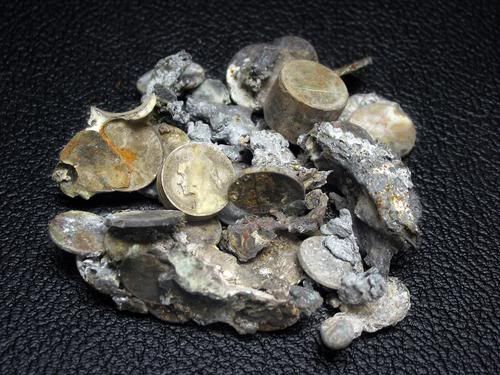Quote:
Originally Posted by NotforSale

To my AFF buddies, just got in from a 20 mile Hammer, and hot, homemade pizza is on the table. I'll be bowing out for the evening!! Hold the Fort!
BTW, my good wife reminded me, people were litterally standing in the gaping hole where the plane had made impact into the Tower. Pretty hot flames, I'd say.
|
You have got to be better at reasoning than this. The impact of an aircraft flying at about 440 miles per hours will propel the wreckage, fuel and debris forward. After an hour or so those who were trapped in the inferno above the impact site made their way down.
If the "the flames" were so commodious for human health, why didn't these people just stay in their cubicles?
A roll of nickels from the WTC. The coins are "frozen" together, I guess.

Quote:
7a. How could the steel have melted if the fires in the WTC towers weren’t hot enough to do so?
OR
7b. Since the melting point of steel is about 2,700 degrees Fahrenheit, the temperature of jet fuel fires does not exceed 1,800 degrees Fahrenheit and Underwriters Laboratories (UL) certified the steel in the WTC towers to 2,000 degrees Fahrenheit for six hours, how could fires have impacted the steel enough to bring down the WTC towers?
In no instance did NIST report that steel in the WTC towers melted due to the fires. The melting point of steel is about 1,500 degrees Celsius (2,800 degrees Fahrenheit). Normal building fires and hydrocarbon (e.g., jet fuel) fires generate temperatures up to about 1,100 degrees Celsius (2,000 degrees Fahrenheit). NIST reported maximum upper layer air temperatures of about 1,000 degrees Celsius (1,800 degrees Fahrenheit) in the WTC towers (for example, see NCSTAR 1, Figure 6-36).
However, when bare steel reaches temperatures of 1,000 degrees Celsius, it softens and its strength reduces to roughly 10 percent of its room temperature value. Steel that is unprotected (e.g., if the fireproofing is dislodged) can reach the air temperature within the time period that the fires burned within the towers. Thus, yielding and buckling of the steel members (floor trusses, beams, and both core and exterior columns) with missing fireproofing were expected under the fire intensity and duration determined by NIST for the WTC towers.
UL did not certify any steel as suggested. In fact, in U.S. practice, steel is not certified at all; rather structural assemblies are tested for their fire resistance rating in accordance with a standard procedure such as ASTM E 119 (see NCSTAR 1-6B). That the steel was “certified ... to 2000 degrees Fahrenheit for six hours” is simply not true.
http://wtc.nist.gov/pubs/factsheets/faqs_8_2006.htm
|
You really shouldn't revel in being so dull.

